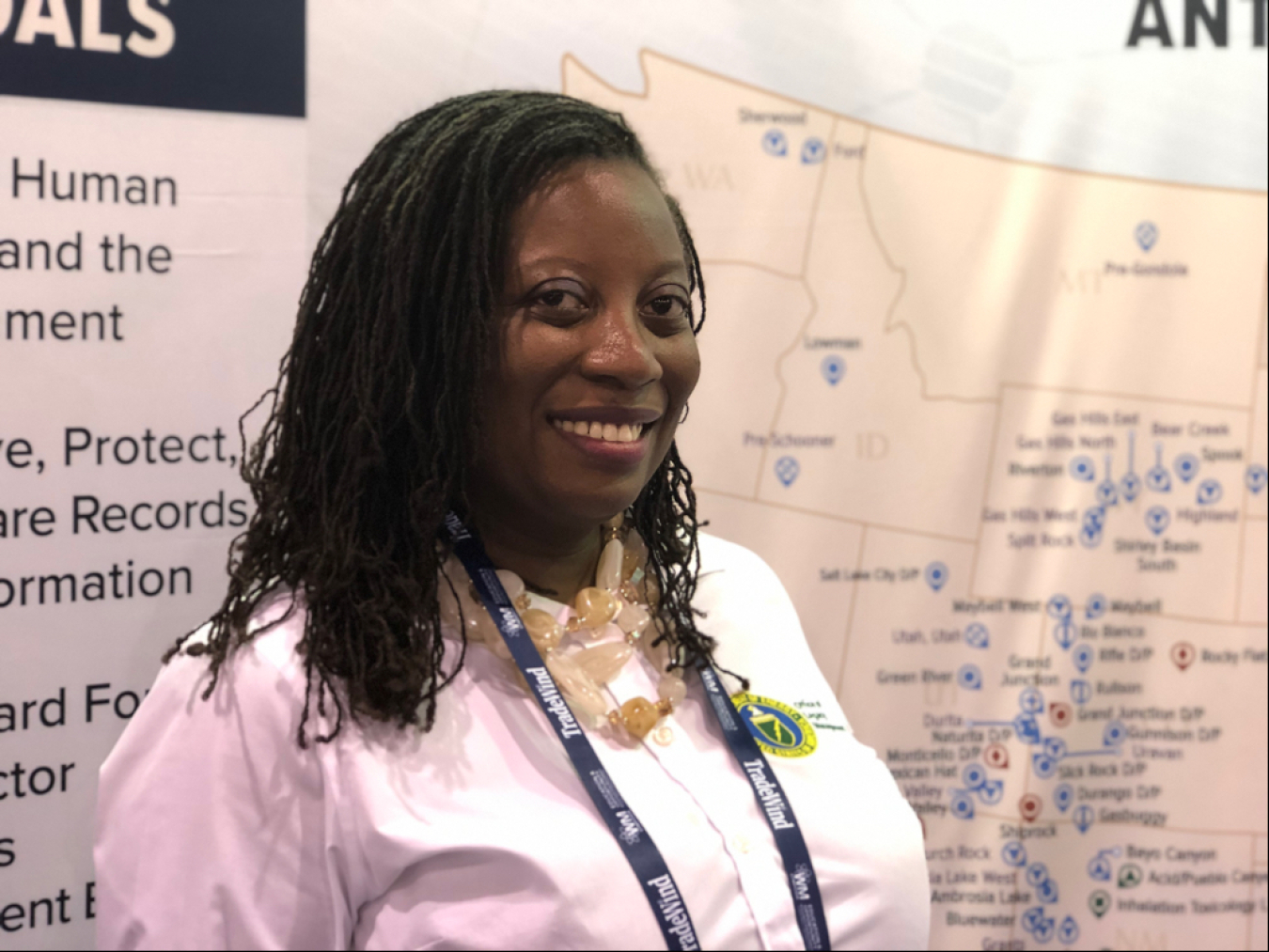Darina Castillo’s passion for the environment led her to LM.
October 7, 2020
Darina Castillo
When Darina Castillo’s love of learning and passion for the environment led her to a career as a site manager at the Department of Energy (DOE) Office of Legacy Management (LM), she never dreamed she would learn so much about history.
“The eye-opening experience for me was that I did not quite appreciate the magnitude of the Manhattan Project and Cold War, and all the effort to get those first bombs built,” Castillo said. “The fact that there are facilities and properties all over the country that contributed to the effort is inspiring and amazing.”
DOE traces its origins to the World War II project led by the U.S. Army Corps of Engineers (USACE) to develop and build the atomic bomb. Today, DOE continues to manage the cleanup and oversee the long-term stewardship of properties at many Manhattan Project and Cold War sites around the country. Castillo is the manager for five current and future LM sites, located in Maryland, New Jersey, New Mexico, and New York.
“The sites that LM manages played an important role in the history of the United States,” she said. “Our long-term stewardship activities, such as ensuring that groundwater remains protective of human health and the environment, are a continuation of that important role and a way to honor our history.”
Plucked from a competitive pool of elite advanced-degree applicants, Castillo was selected to be a Presidential Management Fellow in 2014. This federal leadership development program grooms fellows for careers in public service at the highest levels. Castillo, who has a doctorate in environmental engineering sciences, landed at DOE.
“It was exciting, because it was my first full-time position after my doctorate,” Castillo said. “The work at LM was a great fit with my education and previous professional experiences.”
As part of the fellowship, she also completed a five-month detail with DOE Office of Environmental Management and a one-month stint with the DOE Under Secretary for Science.
“These experiences were very valuable as they gave me a wider breadth of understanding of the workings of the department,” she said.
Castillo — who describes herself as a multidisciplinary environmental engineer with experience in hydrology, environmental policy, remote sensing, and geographic information system mapping — was pleasantly surprised to discover that her role overseeing the cleanup of legacy sites encompassed all that learning and more. She says it was evident from the start that all her strengths honed through science, technology, engineering, and mathematics (STEM) would be called upon.
“I'm able to leverage every aspect of my STEM education at my job, because we have to be multifaceted to perform this work,” she said. “We look at the history of a site to develop solutions for the unique needs of each site, and we need to understand groundwater science, contracting, real estate laws, and environmental regulatory policy as well.”

Castillo visits LM’s Bayo Canyon, New Mexico, Site with colleagues from DOE Office of Environmental Management, LM Strategic Partner, and local officials.
In fact, according to Castillo, it’s that intersection of science and history that even six years into her “first job” sustains her interest on sites requiring periodic monitoring, as well as those that require only minimal attention.
The day-to-day role of LM site managers includes project and contract management, site inspections, groundwater sampling, and meeting with community leaders, such as elected officials and staff from various regulatory agencies.
“During site inspections, we ensure that any remaining contamination at a site remains in a safe configuration,” Castillo said. “For example, we ensure there is no digging in the soil, no one is living in restricted areas, and there are no signs of damage to buildings or disposal cells.”
Among the LM portfolio that Castillo manages is the Colonie site located just outside Albany in upstate New York. This site is part of the Formerly Utilized Sites Remedial Action Program (FUSRAP), a subset of DOE sites where work was performed under contract to the Manhattan Engineer District or U.S Atomic Energy Commission. These sites are selected based on cleanup conditions and become part of LM’s long-term stewardship portfolio once remediation is complete. The Colonie site transferred from USACE to LM in September 2019, six months ahead of schedule.
“The Colonie site is the Office of Legacy Management’s 100th site, so it’s a significant milestone for us, and it also has a rich history,” Castillo said.
Castillo is leading the effort to make two LM sites available for redevelopment, the Colonie site and Middlesex South, New Jersey, Site. The Middlesex South site, which is scheduled to transfer to LM in 2026 under FUSRAP, is slated to become the future home of the local community’s department of public works. This effort will open the doors to millions of dollars of additional redevelopment and hundreds of new jobs. The Colonie site will utilize the U.S. General Services Administration to make the site available for redevelopment. To ensure the success of these projects, Castillo has been coordinating with local redevelopers, elected officials, and regulators and partner agencies on state and federal levels.
“Seeing the direct benefit these redevelopment projects will have on the community is gratifying,” she said.
As a Black woman in a traditionally male-dominated industry, the weight of her own history is not lost on Castillo. In fact, she hopes it shows other young women of color that they, too, can make a difference.
“I occasionally get the opportunity to mentor students of color on choosing the pathway of federal government careers, which isn’t the easiest avenue to navigate,” said Castillo, who makes a point to note to students how gratifying the work can be.
“My work at LM is empowering, because I know that the work we do has a direct impact on the health and safety of the communities where LM’s sites are located.”

